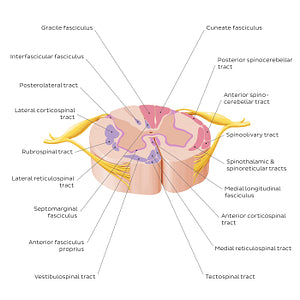Paul Kim
Spinal cord: Cross section (ascending and descending tracts) (English)
Spinal cord: Cross section (ascending and descending tracts) (English)
The white matter of the spinal cord is made of myelinated nerve fibers organized into ascending, descending and intersegmental tracts. Ascending tracts are formed of primary afferent fibers which enter through posterior roots of the spinal nerves. They can be divided into three distinct pathways: the anterolateral system, the posterior column-medial lemniscus pathway and the somatosensory pathways to the cerebellum. The anterolateral system includes the spinothalamic, spinoreticular and spinoolivary tracts, which function to relay sensations of pain, temperature and non-discriminative touch. The posterior column-medial lemniscal pathway is formed by the gracile fasciculus and cuneate fasciculus and relays discriminative touch, vibration, pressure and proprioception. Finally the somatosensory pathways to the cerebellum are composed of the anterior, posterior, and rostral spinocerebellar tracts, which function to relay proprioception, as well as sensations of pain and pressure. Descending pathways are formed of efferent fibers that carry motor information from the brain or brainstem to effector’s muscles. They can be functionally divided into two groups: pyramidal (voluntary) and extrapyramidal (involuntary) tracts. The pyramidal tracts originate in the cerebral cortex and carry motor fibers to the brainstem and spinal cord. They include the anterior and lateral corticospinal tracts. Extrapyramidal tracts begin within the brainstem and carry motor fibers to the spinal cord. They include the tectospinal tract, medial reticulospinal tract, vestibulospinal tract, lateral reticulospinal tract and the rubrospinal tract. Pyramidal tracts are responsible for voluntary control of the muscles of the body, while extrapyramidal tracts are responsible for the involuntary and automatic control.Intersegmental tracts are short ascending and descending tracts which begin and end within the spinal cord. They function to interconnect neurons at different spinal segments and are important in intersegmental spinal reflexes. Intersegmental tracts are composed of the posterolateral tract, medial longitudinal fasciculus, septomarginal fasciculus and interfascicular fasciculus.
Regular price
$7.56 USD
Regular price
Sale price
$7.56 USD
Unit price
per
Couldn't load pickup availability


#DC9E23
#A07792
#DC9E23
#62525C
#FCE372
#CFB3AB

